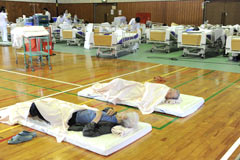Disposal of U.S. unexploded ordnance carried out in a hospital site in Haebaru Town with critically-ill patients remaining on-site

During the bomb disposal, patients and staff members of the hospital wait in the gymnasium of the Samaritan Hospital, at 9:30 am, September 4, Arakawa District, Haebaru Town. (Some images have been adjusted to protect privacy.)
September 5, 2011 Ryukyu Shimpo
Disposal of a U.S. bomb found on the site of the Ureshinogaoka-Samaritan Hospital in the Arakawa District, Haebaru Town, was carried out on the morning of September 4. While this was being done, 200 critically-ill patients and 85 members of the hospital staff stayed on-site because they were unable to evacuate to a safe area. It is extremely rare for this kind of bomb disposal work to be carried out with so many patients and staff members remaining in the hospital and its related facilities within the designated evacuation area (222 meters radius). However, according to the headquarters for the disposal operation headed by Toshiyasu Shiroma, the Mayor of the Haebaru Town, and a spokesperson of the hospital, there have not been any reports of injury or ill-health from the patients and other people.
This operation highlighted the fact that in cases of unexploded ordnance disposal operations, the facilities affected must pay the cost of the evacuation of their patients and staff members because administrative guidelines for people unable to evacuate have not been established by the central government, the local government and the municipalities. The evacuation for the people from the hospital and local residents started at 9:00am and finished at 10:30am. While the evacuation was being carried out, a Ground Self-Defense Forces bomb disposal team removed the fuse from unexploded ordnance in the barrier metal liner plates on the hospital site. This spot was just 20 meters from the outer wall of the building still occupied by many patients and staff members.
Three hundred fifteen people, including patients and others who live in the facilities of Ureshinonosono, Ureshinonosato and Mutsumiryo moved to the nearby Chimugukuru-Kan (Heath Welfare and Disaster Management Center managed by Haebaru Town), to be safe during the disposal operation. About 100 of the 110 residents within the evacuation area went to the facility at Kankyonomori Fureai. The unexploded bomb in question was found on July 25 on the hospital site during reconstruction work.
According to research carried out by the Ryukyu Shimpo, in the ten years since 2002, a total of 16 cases in which hospitals or the welfare facilities have been included within the evacuation areas for unexploded ordnance disposal work. In three of these cases the disposal operations were carried out with people still in the affected facilities.
Toshiyasu Shiroma, Mayor of Haebaru Town, said, “We are very relieved that the bomb disposal work has gone well. But even so, the issue of unexploded ordnance on Okinawa is part of the negative legacy that the Government caused during World War II. By rights, the Government should assume final responsibility for this.”
(English Translation by T&CT, Mark Ealey)
Previous Article:Three performers of Okinawan origin win the top awards in the Ryukyu Classical Art Contest
Next Article:Kumejima Town studies deep water in collaboration with Kona City of Hawaii
[Similar Articles]
- Government to pay the total cost of evacuation in cases of unexploded ordnance disposal operations
- Unexploded ordinance from World War 2 blocks Kokusai Street in Naha for one hour, 2,500 people evacuated
- Unexploded ordnance disposal in Naha City forces 1,700 people to evacuate
- Three unexploded shells found in Shuri High School grounds
- Symposium about unexploded ordnance held in Naha
 Webcam(Kokusai Street)
Webcam(Kokusai Street)


